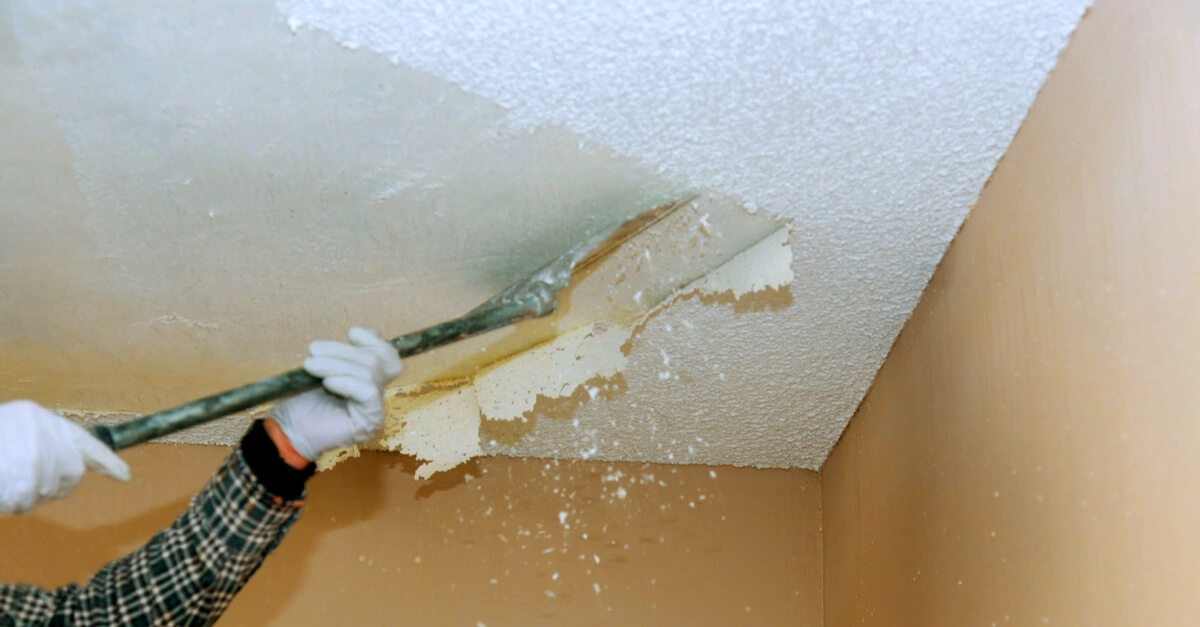Phone:
720-399-3335
Office address:
1685 S. Colorado Blvd. Suite 151, Denver, CO 80222

If your popcorn ceiling was installed before the 1980s, it probably contains asbestos. You can’t tell just by looking, since asbestos fibers are microscopic. Hire a licensed professional to collect and analyze a sample since DIY testing isn’t as accurate and carries risks. If your ceiling’s in good condition, it poses minimal risk. However, if disturbed, it can release dangerous fibers. Monitoring and not disturbing the ceiling can help maintain safety. Wondering how to handle your ceiling safely or considering removal? There’s more to learn on this topic.
Key Takeaways
Popcorn ceilings installed before the 1980s often contain asbestos, which poses significant health risks. Asbestos was commonly used in these textured ceilings from the 1950s to the 1980s due to its heat resistance and fireproofing qualities.
If your home was built or renovated during this period, there’s a good chance the popcorn ceiling has asbestos. It’s essential to test for asbestos before any renovations or repairs to avoid releasing harmful fibers into the air. Visual inspection alone can’t confirm the presence of asbestos, so you should hire a licensed professional for accurate testing.
Knowing if your popcorn ceiling contains asbestos is the first step in managing potential risks to your health and safety.

If you’ve identified asbestos in your popcorn ceiling, you might be wondering about the safety of leaving it undisturbed. Generally, asbestos in good condition poses minimal risk. However, disturbing it can release dangerous fibers into the air.
Here are a few key points to keep in mind:
To determine if your popcorn ceiling contains asbestos, start by understanding that visual inspection alone isn’t sufficient. Asbestos fibers are microscopic and can’t be seen with the naked eye. You’ll need to collect a sample of the ceiling material and have it tested by a certified laboratory.
Hiring a licensed professional to take the sample is the safest option, as improper handling can release harmful asbestos fibers into the air. If you prefer a DIY approach, asbestos testing kits are available, but they come with higher risks and less accuracy.
When dealing with asbestos popcorn ceilings, it’s critical to avoid any actions that might disturb the material and release harmful fibers into the air. Here are some essential tips to help you manage these ceilings safely:
Guaranteeing asbestos popcorn ceilings requires hiring licensed professionals to guarantee safety and compliance with regulations. Asbestos removal isn’t a DIY task; improper handling can release harmful fibers, posing serious health risks.
Licensed abatement professionals use specialized equipment and follow strict safety protocols. They’ll seal the area, use HEPA filters, and make sure of proper disposal of asbestos waste. Before starting, verify the contractor’s credentials and discuss the removal process in detail.
Keep the area off-limits to people and pets during the procedure. Always prioritize professional help for asbestos removal to protect your health and avoid legal issues. Remember, safe removal not only prevents exposure but also ensures your home meets safety standards.
Need help navigating asbestos popcorn ceiling removal? Our team is here to help — call (720) 399-3335 now.
When it comes to home trends, “what goes around, comes around.” Popcorn ceilings were most commonly installed between the 1950s and 1980s. If your home was built or renovated during this period, it likely has one.
Asbestos exposure can cause serious health issues like lung cancer, mesothelioma, and asbestosis. Inhaling asbestos fibers leads to lung scarring and increases disease risk. Always test for asbestos and avoid disturbing potential sources.
Over 50% of existing homes may contain asbestos. You can’t detect asbestos in popcorn ceilings visually. Asbestos fibers aren’t visible to the naked eye, so hire a professional for accurate testing before any renovation work.
If you suspect asbestos in your ceiling, don’t disturb it. Hire a licensed professional to test a sample. If asbestos is present, follow their guidance for safe removal or encapsulation to prevent health risks.
Professional asbestos testing is recommended over DIY kits because it’s like using a magnifying glass versus a microscope. Professionals guarantee accuracy, safety, and compliance with regulations, preventing health risks that DIY kits might miss or mishandle.